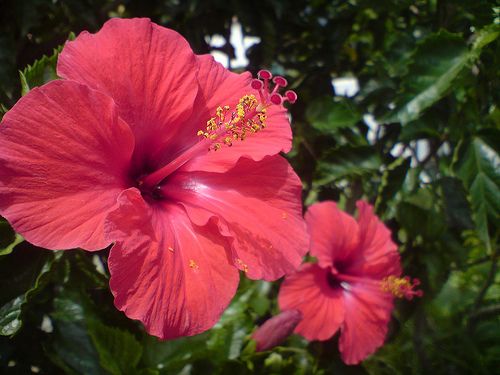
Properties
· Considered emollient, emmenagogue, anodyne, expectorant, refrigerant.
· Anti-infectious, anthelmintic, antiinflammatory, diuretic, antipyretic.
· Hypotensive, antispasmodic.
· Prepared drug has sweet taste, neutral natured.
· The Hibiscus with five petals noted for its medicinal properties, the flowers are considered astringent. The roots contain a mucilage that is soothing on the mucous membranes of the digestive and respiratory tracts.
· Proanthocyanidins are considered antioxidant, antipyretic, analgesic, spasmolytic.
Constituents
- Flowers reported to yield hisbiscetin.
- Flowers yield polyphenols, flavonoids and anthocyanins.
- Polysaccharides which promote wound healing and are immune-modulating.
- Studies have isolated flavonoids, cyanidin, quercetin, hentriacontane, calcium oxalate, thiamine, riboflavin, niacin, ascorbic acid.
Parts utilized
· Flowers, roots, and leaves.
· Harvest the roots and leaves anytime of the year.
· Wash, cut into slices, and sun-dry. The flowers should be collected from May to August, sun-dry.
Uses
In the Philippines, flower buds, beaten to a paste, applied as poultice to boils, cancerous swellings, and mumps.
·Poultice of leaves and flower buds applied externally to swellings; the same mixture, with the addition of lime, hastens the maturation of tumors.
· Mumps, infection of the urinary tract: use dried drug materials 15 to 30 gms, boil to decoction and drink.
· For abscesses, carbuncles and boils: crush fresh leaves and poultice the infected area.
· Decoction of roots, barks, leaves and flowers used as an emollient.
· Decoction from roots of red and white-flowered plants is a Kelantan antidote for poison. Same decoction is drunk for venereal diseases and fevers.
· Decoction of roots also used for coughs.
· Decoction of flowers and or roots used as natural diuretic.
· Bark is an emmenagogue; also used to normalize menstruation.
· Malays uses a decoction of leaves as a lotion for fevers, and the roots for glands in the neck.
· Infusion or poultice of leaves used for headaches.
· In China, leaves used as emollient, anodyne, and a gentle aperient.
· Decoction of root used as drops for sore eyes.
· Seeds used as a stimulant and for cramps.
· Decoction of leaves for fevers.
· For headaches, an infusion of leaves or poultice of leaves.
· Leaves are mildly laxative.
· Mucilage applied during labor.
· Juice of leaves, along with that of Vernonia cinerea, used by midwives to stimulate the expulsion of the placenta
· In the Dutch Indies the red flowers are used to regulate menstruation; also, considered somewhat purgative and sometimes said to cause abortion
· In Sind, flowers are fried in clarified butter and used for checking excessive menstruation
· Red flowers used for sprue.
· Infusion of flowers and leaves used as expectorant in bronchitis
· The Chinese and Annamites use the flowers for paralysis and dysmenorrhea.
· Infusion of flowers, exposed all night to the dew, used for gonorrhea.
· Flowers fried in ghee, given for menorrhagia. The dark red petals are used as a mucilaginous infusion for painful urination, strangury, cystitis, and other irritable genitourinary conditions
· Infusion used as a refrigerant drink for fevers and as demulcent for coughs.
· Red flowers are purgative; when taken with papaya seeds, may be abortive.
· Hair stimulant: oil made by mixing the juice of fresh petals and olive oil in equal proportions, and boiled till the water has evaporated, used for stimulating hair growth.
· Seeds, pounded to a pulp and mixed with water, used for gonorrhea.
· In Costa Rica, used as a purgative.
· In Venezuela, used to treat tumors.
· In the Caribbean, used as analgesic, anti-inflammatory.
· In the Dominican Republic, used to treat hematomas.
Availability
Wild-crafted.
Cultivated for ornamental use.
good article
ReplyDeletetaruhan judi dewa poker terpercaya